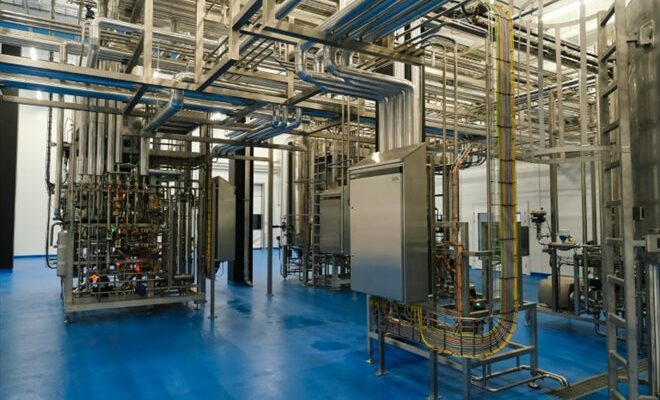A container containing a food protein called Solein at the headquarters of the Solar foods company in Vantaa, Finland, May 2, 2024 (AFP/Alessandro RAMPAZZO)
In this Finnish factory, the “farmers of the future”, hunched over their computers, produce a food protein by feeding a microbe with air and electricity, far from traditional agriculture.
Cellular agriculture, which involves producing food or nutrients from cell cultures, is increasingly seen as an environmentally friendly alternative to livestock farming, a major contributor to greenhouse gas emissions.
Meat, eggs and milk produced in the laboratory have aroused the interest of scientists who have tried their hand at culturing animal cells. But for its detractors, the process is considered “unnatural” and energy-consuming and expensive.
The Solar Foods Group is going beyond this and at its recently opened site near Helsinki, scientists are deploying new technology to grow proteins from cells, using air and electricity.

An air filter used to capture CO2 in the air at the headquarters of the Solar Foods company in Vantaa, Finland, on May 2, 2024 (AFP/Alessandro RAMPAZZO)
A microbe is supplied with carbon dioxide, hydrogen and minerals in a process using electricity from renewable sources.
Solar Foods has managed to create a protein-rich powder that can be used as an egg or milk substitute.
“We can get our main raw material for the microbe from the air,” Pasi Vainikka, managing director of Solar Foods, told AFP during a tour of the company’s new facilities.
“We have launched the production of the most sustainable protein in the world,” he says.
Founded by Vainikka and Juha-Pekka Pitkanen in 2017, Solar Foods opened its “world’s first factory that grows food from air” in April.
“A lot of animal protein today can actually be produced by cellular agriculture and we can free up agricultural land and thus replenish a carbon stock,” says Mr. Vainikka, referring to the process by which Forests and soils absorb and store carbon.

A dish made from the food protein Solein at the headquarters of the Solar foods company in Vantaa, Finland, on May 2, 2024 (AFP/Alessandro RAMPAZZO)
A kilo of this new protein, called “solein”, emits 130 times less greenhouse gases than the same quantity of protein from beef in the European Union, according to a study by sustainable food specialists from the University of Helsinki cited by Solar Foods.
In the factory laboratory and control center, around ten people monitoring production on their screens.
“These are our future farmers,” said the leader.
– Part of the solution –
Transforming food production and consumption is at the heart of the fight against global warming and the loss of biodiversity, notes Emilia Nordlund, head of food research at the Finnish public research organization VTT.

Chef Miikka Manninen makes a dessert with ingredients created from the Solein protein, at the headquarters of the Solar foods company in Vantaa, Finland, May 2, 2024 (AFP/Alessandro RAMPAZZO)
Meat consumption is expected to increase further in the coming years, according to projections.
“Industrial food production, particularly livestock farming, is one of the main causes of greenhouse gas emissions (and) loss of biodiversity, eutrophication and use of fresh water,” recalls the scientist.
New food production technologies can help reduce emissions caused by intensive agriculture and “diversify food production”, she assures.
“At the same time, we need to improve existing food production methods to make them more sustainable and resilient,” she adds.

The headquarters of the Solar foods company in Vantaa, Finland, May 2, 2024 (AFP/Alessandro RAMPAZZO)
Fermentation technologies used to produce nutrients have existed for decades but their development has accelerated with the emergence of new research projects around the world.
“The field is in an expansion phase, with the first demonstration factories built, such as the Solar Foods factory in Finland,” explains the expert.
-Fermentation-
The United States, the United Kingdom, Germany, the Netherlands and Israel are among the countries most active in cellular agriculture.
“We are in a crucial phase, we will see which start-ups will survive,” she adds, believing that administrative obstacles are slowing down their development in the European Union.

Solar Foods CEO Pasi Vainikka at the company’s headquarters in Vantaa, Finland, May 2, 2024 (AFP/Alessandro RAMPAZZO)
Wearing protective gear to prevent bacterial contamination in the factory, Mr. Vainikka shows off a giant steel tank.
“It’s a 20,000 liter capacity fermenter,” he says, and the microbe multiplies inside the tank when supplied with greenhouse gases.
The liquid containing the microbes is extracted from the vat and transformed into a yellowish, protein-rich powder with a “nutty” and “creamy” taste.
“The fermenter produces as much protein every day as 300 dairy cows or 50,000 laying hens,” assures Vainikka, or the equivalent of five million annual meals for protein intake.

A production area of the Solar foods company in Vantaa, Finland, May 2, 2024 (AFP/Alessandro RAMPAZZO)
In the immediate future, the main objective of the small Finnish factory, which employs around forty people, is to “prove that the technology is viable”, in order to attract the necessary investments while awaiting European regulatory approval.
The protein has been approved for sale in Singapore where some restaurants include it in ice cream but it has still not been classified as a food product in the EU and US.
To have a real impact, the goal is to “build a factory 100 times bigger than this one,” says Mr. Vainikka.
© 2024 AFP
Did you like this article ? Share it with your friends using the buttons below.




